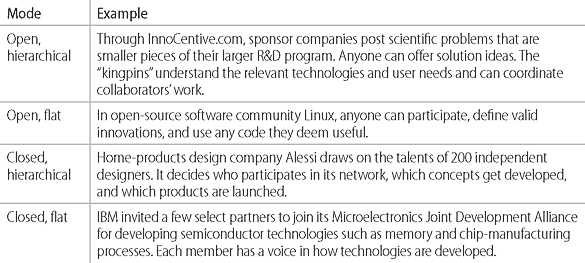Which Kind of Collaboration Is Right for You?
The Idea in Brief
Understanding Your Collaboration Options
As potential innovation partners and ways to collaborate with them proliferate, it's tough deciding how best to leverage outsiders' power.
To select the right type of collaboration options for your business, Pisano and Verganti recommend understanding the four basic collaboration modes. These modes differ along two dimensions: openness (can anyone participate, or just select players?) and hierarchy (who makes key decisions — one "kingpin" participant or all players?).
In the open, hierarchical mode, anyone can offer ideas but your company defines the problem and chooses the solution.
Examples of Collaboration Options
- In the open, flat mode, anyone can solicit and offer ideas, and no single participant has the authority to decide what is or isn't a valid innovation.
- In the closed, hierarchical mode, your company selects certain participants and decides which ideas get developed.
- In the closed, flat mode, a select group is invited to offer ideas. But participants share information and intellectual property and make critical decisions together.
Choosing Your Collaboration Approach
Each mode has trade-offs. For example, open networks (whether hierarchical or flat) produce many ideas, but screening them is costly. What to do? Choose modes best suited to your capabilities. For instance, if you can evaluate ideas cheaply but no single participant has all the necessary expertise to shape the innovation, use an open, flat collaboration.
The Idea in Practice
Select the collaboration mode that best suits your capabilities and strategy.
In developing the iPhone and its applications, Apple initially used closed, hierarchical networks, where it could better control components influencing users' experiences. But once the iPhone was established, Apple defined a growth strategy hinging on adding software functionality and applications. Because it knew it couldn't anticipate all the applications iPhone users might value, it switched to an open, flat network: It introduced a kit allowing third-party developers to create applications based on the iPhone OS platform and to provide them to users directly through the device.
Further Reading
Articles
Innovating from the Outside In, 2nd Edition
HBR Article Collection
June 2007
To drive top-line growth, you must constantly generate new products and services. But don't ask your R&D team to shoulder the entire burden of innovating. In many firms, R&D productivity is flattening while innovation budgets are climbing faster than revenues. A better approach to innovation? Gather promising ideas outside your company. Then commercialize them quickly and inexpensively, using your firm's R&D, manufacturing, and marketing prowess. To source ideas, consider using innovation headhunters--associations that connect your company with universities, labs, consultants, and firms that can develop solutions to your innovation challenges. An innovation capitalist can help you shop for promising raw ideas and will develop them enough for you to evaluate their manufacturing feasibility. To commercialize attractive ideas you've gathered externally, forge joint ventures and licensing arrangements with organizations that have the skills to bring the best concepts to market.
Book
Open Business Models: How to Thrive in the New Innovation Landscape
HBS Press
October 2006
by Henry W. Chesbrough
In his landmark book Open Innovation, Henry Chesbrough demonstrated that because useful knowledge is no longer concentrated in a few large organizations, business leaders must adopt a new, "open" model of innovation. Using this model, companies look outside their boundaries for ideas and intellectual property (IP) they can bring in, as well as license their unutilized home-grown IP to other organizations. In Open Business Models, Chesbrough explains how to make money in an open innovation landscape. He provides a diagnostic instrument enabling you to assess your company's current business model and explains how to overcome common barriers to creating a more open model. Chesbrough also describes a new set of players--"innovation intermediaries"--who facilitate companies' access to external technologies.
- Purchase the full-length Harvard Business Review article here.
- Visit Harvard Business Online.
- See more on Leadership and Managing People at Harvard Business Online.
Copyright (c) 2008 Harvard Business School Publishing Corporation. All rights reserved.

